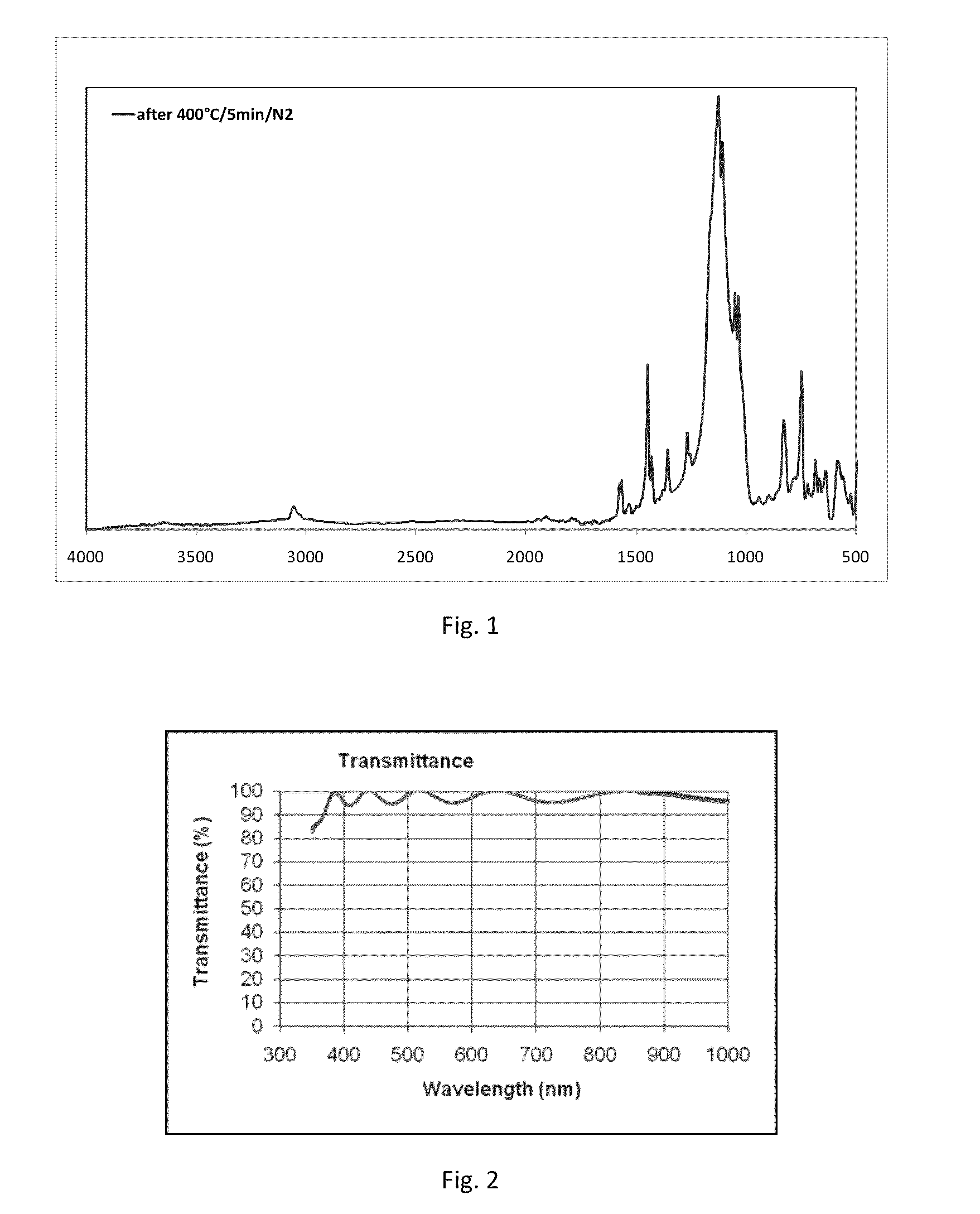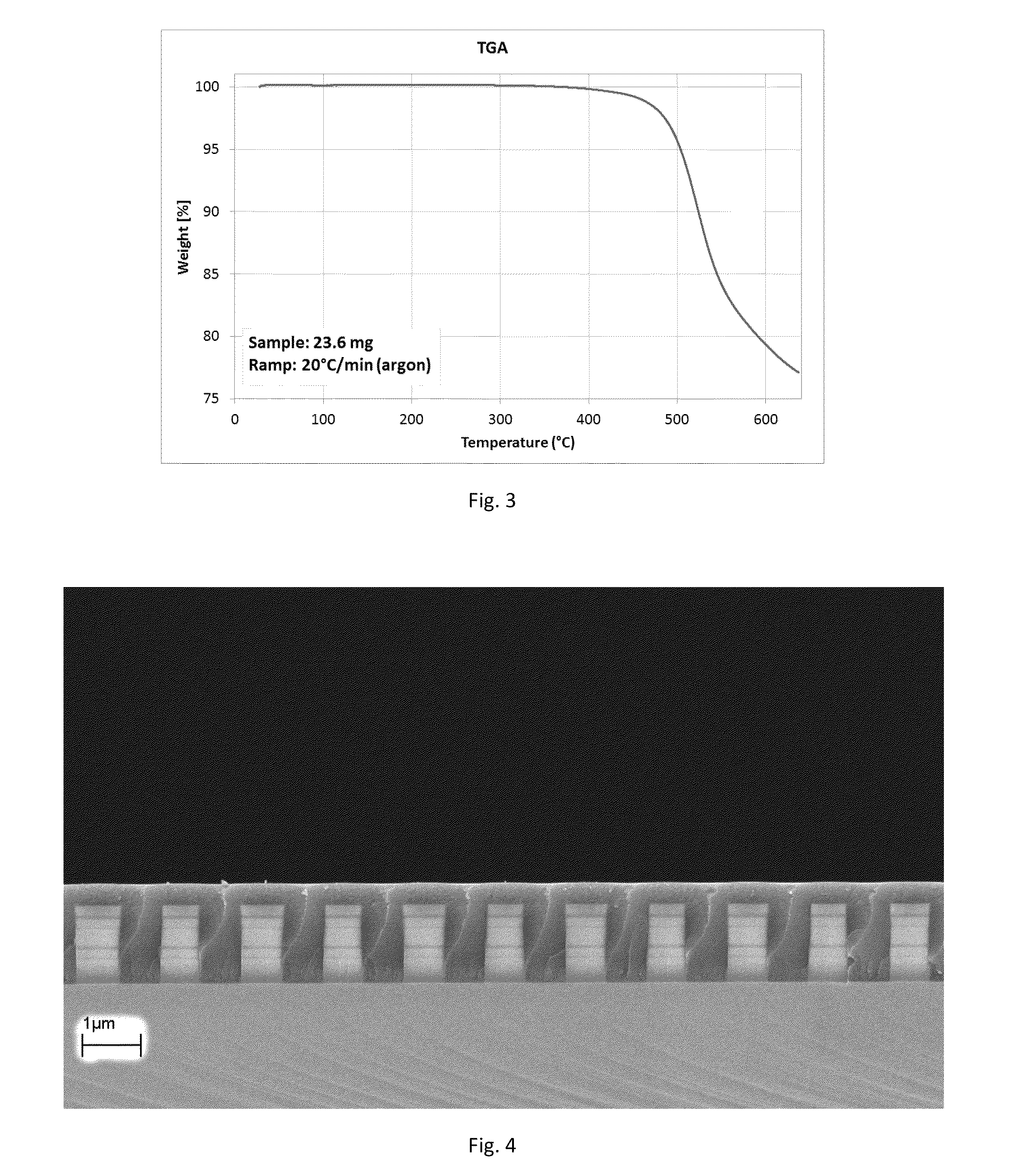Organometallic monomers and high refractive index polymers derived therefrom
a high refractive index, polymer technology, applied in the direction of organic chemistry, organic chemistry, chemical instruments and processes, etc., can solve the problems of cmos image sensor blue light performance, material cannot be used as high refractive optical materials without further compromising the blue light performance of cmos image sensors, and achieve high refractive index, high thermal stability, and easy curability
- Summary
- Abstract
- Description
- Claims
- Application Information
AI Technical Summary
Benefits of technology
Problems solved by technology
Method used
Image
Examples
example 1
[0092]Thianthrene (21 g, VWR International) was placed in a 250 mL rb flask along with dichloromethane (DCM, 150 mL) and trifluoroacetic acid (TFAA, 6 mL). A small amount of iodine (0.4 g) was added, and bromine (19 g) was metered in. The reaction was allowed to proceed for 24 hours at +23° C. It was then taken to rotary evaporator and DCM was removed at 45° C. / 40 mbar and recycled (over 90%) for a new batch without reduction in yield. Toluene (100 mL) was added, and evaporation was continued until no vapors came out at 60° C. / 15 mbar. A light red viscous material remained, which started crystallizing slowly upon cooling.
example 2a
[0093]
[0094]The material from example 1 was dissolved in dry THF (150 mL), and chlorotriethoxysilane (21 g) and magnesium turnings (4 g) were added. The flask was heated to reflux, until the reaction started. After 2 hours reaction, GC / MS was run of the reaction solution, which showed that there was 2.3% thianthrene, 86.0% 2-(triethoxysilyl)thianthrene and 3.5% 2,8- and 2,7-bis(triethoxysilyl)thianthrene formed. Hexanes (100 mL) was added to the solution to precipitate magnesium salts. The liquid was taken to rotary evaporator, and volatiles were removed at 60° C. / 20 mbar. The product 2-(triethoxysilyl)thianthrene was distilled under vacuum, bp. 190° C. / 0.1 mbar, Yield 12.4 g (purity 98.6% by GC / MS) as colorless liquid which crystallized slowly upon standing overnight.
example 2b
[0095]
[0096]2-(Triethoxysilyl)thianthrene (5 g) from example 2A was dissolved in acetone (2.5 mL). One drop of trifluoroacetic acid and two drops of 0.5% HCl were added. DIW (1.5 g) was slowly dripped in. The solution was heated at 65° C. for two hours. DIW (10 mL) and methyl t-butyl ether (30 mL) were added. The organic phase was separated and vacuum-dried in rotary evaporator (60° C. / 15 mbar). The resulting white solid polymer (4.5 g, Mw / Mn=1,221 / 1,033 by GPC) was dissolved in MEK (21 g), surfactant (45 mg, BYK®306 by BYK Chemie GmbH) was added, followed by filtration through a 0.2μ PTFE filter. The solution was spin coated on a silicon wafer at 1000 rpm, followed by soft bake at 150° C. / 5 min and cure at 200 to 240° C. for 10 min under nitrogen. A 752 nm crack-free and defect-free film with RI=1.72 was obtained. The film was soaked in acetone (30 min, 23° C.) without change to its thickness, RI or other properties. The film was also baked at 400° C. / 5 min / argon, and only 2.8% thi...
PUM
| Property | Measurement | Unit |
|---|---|---|
| RI | aaaaa | aaaaa |
| temperatures | aaaaa | aaaaa |
| temperatures | aaaaa | aaaaa |
Abstract
Description
Claims
Application Information
 Login to View More
Login to View More - R&D
- Intellectual Property
- Life Sciences
- Materials
- Tech Scout
- Unparalleled Data Quality
- Higher Quality Content
- 60% Fewer Hallucinations
Browse by: Latest US Patents, China's latest patents, Technical Efficacy Thesaurus, Application Domain, Technology Topic, Popular Technical Reports.
© 2025 PatSnap. All rights reserved.Legal|Privacy policy|Modern Slavery Act Transparency Statement|Sitemap|About US| Contact US: help@patsnap.com



